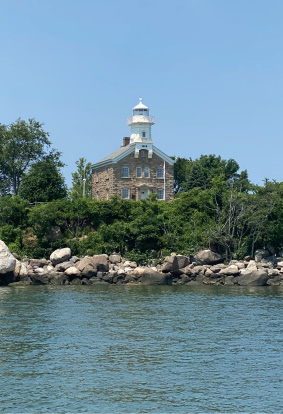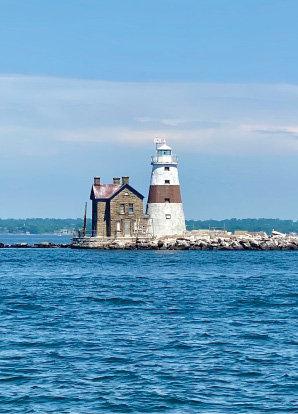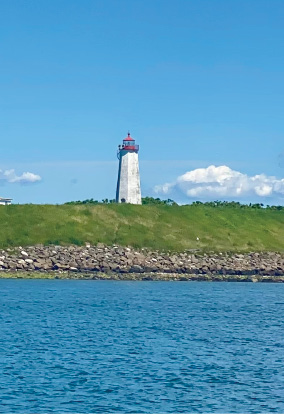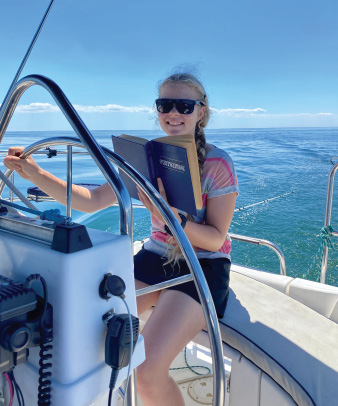By Valeriia Povysheva

Great Captain Island, off Greenwich, CT, was built in 1868.
It is easy to take lighthouses for granted now that GPS and other navigational technologies exist. Sailors today use buoys, radars, and online nautical charts for navigation. And yet sailing used to be dependent on lighthouses.
From their impact on local communities to the whaling industry (since one of the primary uses of whale oil was lamps), lighthouses hold a huge historical and cultural significance. In fact, the first public infrastructure program by the US government was none other than the Lighthouse Act in 1789. Honoring these “beacons of hope” to this day connects us to the history of this country and our favorite pastime, sailing.
Lighthouses can be seen all across the Long Island Sound, marking the entrance to a harbor or helping you safely pass islands. Each one is unique in its both historical and modern story. Some are considered haunted, some are still in use, some have been turned into museums, and others are privately owned. The beauty of traveling by sailboat is that no matter whether they have public/road access, they can be seen (and admired) from the sea.
Our family has been sailing the Long Island Sound for three summers, and we have seen over 22 lighthouses from our sailboat. Our favorite way to see lighthouses is to anchor a couple of hundred feet off the coast (our draft is 1.5 meters/5 feet) and swim to the shore.
My mother and I would swim (it’s often quite a challenge!), while my dad and six-year-old sister would ride in our dinghy. Of course, not all lighthouses are reachable this way, but the ones that are, create an incredibly memorable experience.
The first time we swam to a lighthouse was at Great Captain Island. This lighthouse was constructed in 1868, and since 1973 it has belonged to the town of Greenwich. It is also a nesting place for egrets, many of whom can be seen perched on the trees of the island. We took a walk along the beach to watch the sunset and admire the lighthouse views and birds, but this was not what stood out the most.

Located at the western end of Long Island Sound, Execution Rocks Lighthouse is said to be haunted by ghosts of prisoners condemned to die during the American Revolution. Chained to rocks when the tide was low, they drowned in
The beaches of Long Island Sound, home to all kinds of birds and vegetation are often littered with plastic. It is impossible to pay attention to the beauty of lighthouses without noticing the trash surrounding them. In our search for Long Island Sound lighthouses, we have seen firsthand the severe trash pollution, so we try to engage in personal and community beach cleanup efforts.
Our biggest sailing trip thus far has been from our marina in Stamford to Mystic Seaport Museum in August of 2022. During our journey, we saw many old and some new lighthouses. Each time we passed one was a mini benchmark for our trip, and we would stop to take pictures and enjoy the architecture.
Afterward, we would research the lighthouse to discover when/why it was built and other information. My favorite lighthouse story is that of the North Dumpling Light. Not only is the name amusing, but this lighthouse also has some historical mystery to it.
During Prohibition, bootlegging was popular on the nearby Fishers Island. The keeper of North Dumpling Light was accused of aid to the illegal activities, due to two instances of ships that carried alcohol grounding in the area, and the alcohol disappearing by the time Coast Guard arrived. To this day it is unknown what happened to the illegal cargo.
The lighthouses along the Sound are a huge part of its history, so it shouldn’t be overlooked. We even have our own Eiffel Tower, also known as Faulkner’s Island Lighthouse! Thomas Jefferson commissioned it for construction in 1802, and while it is only 40ft/12 m tall (944 feet to go to rival the actual Eiffel Tower), it is significant as the second oldest lighthouse in Connecticut and as a nesting place for the endangered roseate tern.

Commissioned by President Thomas Jefferson in 1802, Faulkner’s Island Lighthouse has been called the Eiffel Tower of Long Island Sound.
The oldest lighthouse on Long Island Sound is the New London Harbor lighthouse. It was opened in 1760, a time when New London was the third busiest whaling port in the world.
Whaling brought wealth to the city and shaped its future, and the lighthouse saw this golden era as well as the eventual decline of whaling. Whales were hunted mainly for baleen (a whale’s filter-feeding system) and blubber. Baleen could be used for a variety of products including corsets, hairbrushes, and buggy whips, while whale blubber was boiled into oil and used for soap and to light lamps.
Whale bones were also sometimes used for things like umbrella frames, skirt hoops, or furniture springs. Over 250 ships sailed for whaling voyages from New London between 1718 and 1908, bringing back these desired products and thus wealth to Connecticut. ■

The author enjoys a book (in her native Russian) at the helm.
Valeriia Povysheva, 14, was born in Ukraine and moved to the United States when she was 4. A 9th grader, she writes and reads in both Russian and English. Her family’s thoroughly enjoyable travel blog, As We Go Places (documenting twenty-seven national parks and ten countries they’ve visited so far), can be found at aswegoplaces.com.



